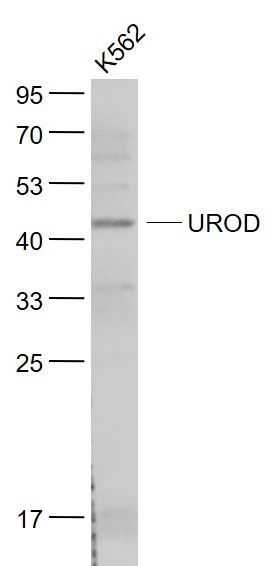UROD Polyclonal Antibody
Purified Rabbit Polyclonal Antibody (Pab)
- 产品详情
- 实验流程
Application
| WB, IHC-P, IHC-F, IF, E |
|---|---|
| Primary Accession | P06132 |
| Reactivity | Rat, Dog |
| Host | Rabbit |
| Clonality | Polyclonal |
| Calculated MW | 40787 Da |
| Physical State | Liquid |
| Immunogen | KLH conjugated synthetic peptide derived from human UROD |
| Epitope Specificity | 121-220/367 |
| Isotype | IgG |
| Purity | affinity purified by Protein A |
| Buffer | 0.01M TBS (pH7.4) with 1% BSA, 0.02% Proclin300 and 50% Glycerol. |
| SUBCELLULAR LOCATION | Cytoplasm. |
| SIMILARITY | Belongs to the uroporphyrinogen decarboxylase family. |
| SUBUNIT | Homodimer |
| DISEASE | Defects in UROD are the cause of familial porphyria cutanea tarda (FPCT) [MIM:176100]; also known as porphyria cutanea tarda type II. FPCT is an autosomal dominant disorder characterized by light-sensitive dermatitis, with onset in later life. It is associated with the excretion of large amounts of uroporphyrin in the urine. Iron overload is often present in association with varying degrees of liver damage. Besides the familial form of PCT, a relatively common idiosyncratic form is known in which only the liver enzyme is reduced. This form is referred to as porphyria cutanea tarda "sporadic" type or type I [MIM:176090]. PCT type I occurs sporadically as an unusual accompaniment of common hepatic disorders such as alcohol-associated liver disease. Defects in UROD are the cause of hepatoerythropoietic porphyria (HEP) [MIM:176100]. HEP is a rare autosomal recessive disorder. It is the severe form of cutaneous porphyria, and presents in infancy. The level of UROD is very low in erythrocytes and cultured skin fibroblasts, suggesting that HEP is the homozygous state for porphyria cutanea tarda. |
| Important Note | This product as supplied is intended for research use only, not for use in human, therapeutic or diagnostic applications. |
| Background Descriptions | UROD is the fifth enzyme of the heme biosynthetic pathway. This enzyme is responsible for catalyzing the conversion of uroporphyrinogen to coproporphyrinogen through the removal of four carboxymethyl side chains. Mutations and deficiency in this enzyme are known to cause familial porphyria cutanea tarda and hepatoerythropoetic porphyria. Porphyria cutanea tarda is an autosomal dominant disorder characterized by light-sensitive dermatitis and associated with the excretion of large amounts of uroporphyrin in urine. Hepatoerythropoetic porphyria is a form of porphyria cutanae tarda that may also be a manifestation of benign or malignant hepatic tumors. |
| Gene ID | 7389 |
|---|---|
| Other Names | Uroporphyrinogen decarboxylase, UPD, URO-D, 4.1.1.37, UROD |
| Dilution | WB=1:500-2000,IHC-P=1:100-500,IHC-F=1:100-500,IF=1:100-500,ELISA=1:5000-10000 |
| Format | 0.01M TBS(pH7.4) with 1% BSA, 0.09% (W/V) sodium azide and 50% Glyce |
| Storage | Store at -20 °C for one year. Avoid repeated freeze/thaw cycles. When reconstituted in sterile pH 7.4 0.01M PBS or diluent of antibody the antibody is stable for at least two weeks at 2-4 °C. |
| Name | UROD (HGNC:12591) |
|---|---|
| Function | Catalyzes the sequential decarboxylation of the four acetate side chains of uroporphyrinogen to form coproporphyrinogen and participates in the fifth step in the heme biosynthetic pathway (PubMed:11069625, PubMed:11719352, PubMed:14633982, PubMed:18004775, PubMed:21668429). Isomer I or isomer III of uroporphyrinogen may serve as substrate, but only coproporphyrinogen III can ultimately be converted to heme (PubMed:11069625, PubMed:11719352, PubMed:14633982, PubMed:21668429). In vitro also decarboxylates pentacarboxylate porphyrinogen I (PubMed:12071824). |
| Cellular Location | Cytoplasm, cytosol {ECO:0000250|UniProtKB:P70697} |
Research Areas
For Research Use Only. Not For Use In Diagnostic Procedures.
Application Protocols
Provided below are standard protocols that you may find useful for product applications.
终于等到您。ABCEPTA(百远生物)抗体产品。
点击下方“我要评价 ”按钮提交您的反馈信息,您的反馈和评价是我们最宝贵的财富之一,
我们将在1-3个工作日内处理您的反馈信息。
如有疑问,联系:0512-88856768 tech-china@abcepta.com.
¥ 1,500.00
Cat# AP58277























 癌症的基本特征包括细胞增殖、血管生成、迁移、凋亡逃避机制和细胞永生等。找到癌症发生过程中这些通路的关键标记物和对应的抗体用于检测至关重要。
癌症的基本特征包括细胞增殖、血管生成、迁移、凋亡逃避机制和细胞永生等。找到癌症发生过程中这些通路的关键标记物和对应的抗体用于检测至关重要。 为您推荐一个泛素化位点预测神器——泛素化分析工具,可以为您的蛋白的泛素化位点作出预测和评分。
为您推荐一个泛素化位点预测神器——泛素化分析工具,可以为您的蛋白的泛素化位点作出预测和评分。 细胞自噬受体图形绘图工具为你的蛋白的细胞受体结合位点作出预测和评分,识别结合到自噬通路中的蛋白是非常重要的,便于让我们理解自噬在正常生理、病理过程中的作用,如发育、细胞分化、神经退化性疾病、压力条件下、感染和癌症。
细胞自噬受体图形绘图工具为你的蛋白的细胞受体结合位点作出预测和评分,识别结合到自噬通路中的蛋白是非常重要的,便于让我们理解自噬在正常生理、病理过程中的作用,如发育、细胞分化、神经退化性疾病、压力条件下、感染和癌症。






